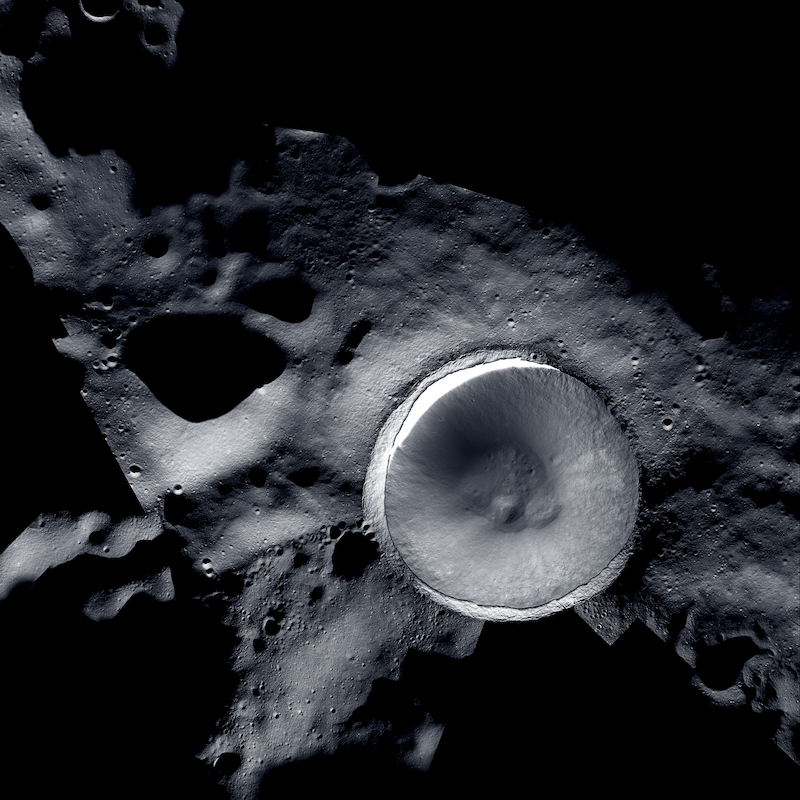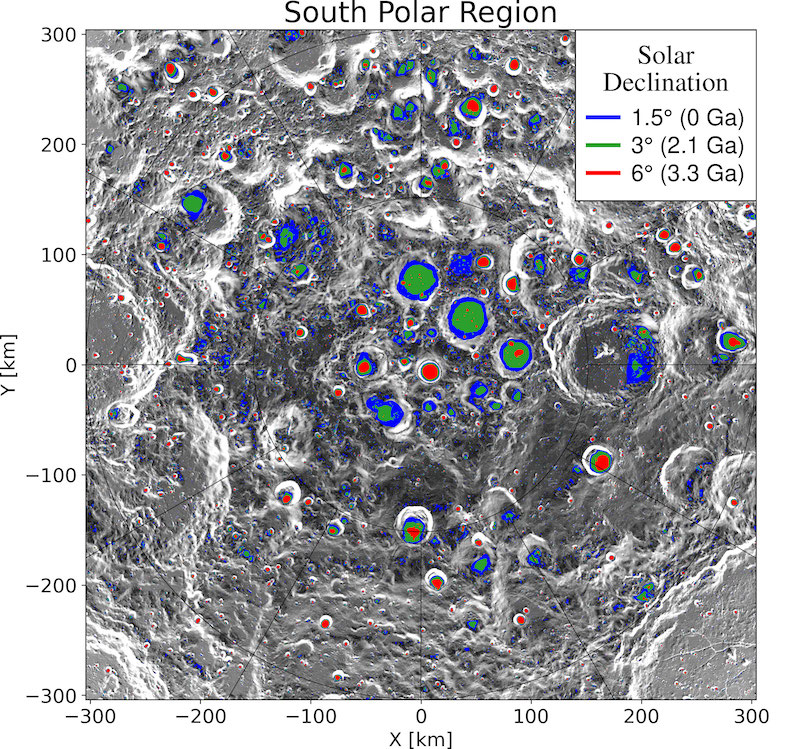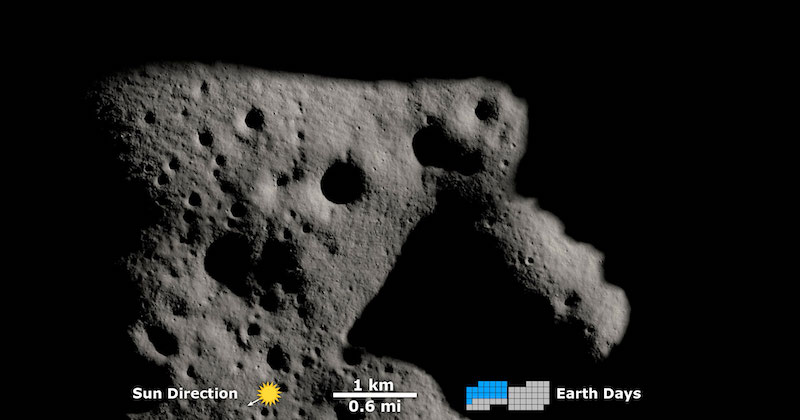
We know there is water ice on the moon, hiding in permanently shadowed craters at the poles. But how old is that ice, and how much of it is there? Scientists at the Planetary Science Institute (PSI) and Southwest Research Institute (SwRI) announced a new study on September 13, 2023, that suggests this ice is both younger and less extensive than scientists previously thought. This could have implications for future human habitation on the moon, because astronauts will need water ice for drinking and for fuel.
The researchers published their peer-reviewed findings in Science Advances on September 13, 2023.
The moon’s permanently shadowed regions
The study focused on areas at the moon’s poles that are permanently in shadow. Scientists call these permanently shadowed regions. The moon’s axis tilts only 1.5 degrees from the plane of the ecliptic (the path of the planets around the sun). Because of this unique geometry, sunlight never shines on the floors of some craters near the moon’s poles. But, around 4.1 billion years ago, the young, newly formed moon had a more tilted spin axis than it has today. As the tilt decreased, these permanently shadowed regions appeared at the poles and grew over time. The paper explained:
As the moon migrated away from Earth, it experienced a major spin axis reorientation. Permanently shadowed regions, which are thought to have trapped ices and are a main focus of lunar exploration, appeared and grew after this transition and are often younger than their host craters.
The researchers used AstroGeo22, a new Earth-moon evolution simulation tool, to calculate the moon’s axial tilt over time. Then, combined with surface height measurements from the Lunar Orbital Laser Altimeter (LOLA) data, the team estimated the evolution of the shadowed areas over time.
Permanently shadowed regions are younger
Scientists have thought that the permanently shadowed regions were as ancient as the moon itself. But that may not be true, after all. The first clues came from a group of researchers in France last year, regarding the ever-slightly changing distance between the Earth and moon and the orientation of the moon’s spin axis. That affects how many permanently shadowed regions there are. And that, in turn, determines how much water ice can exist in those regions.
As lead author Norbert Schörghofer at the Planetary Science Institute explained:
When I heard about their result, I immediately realized it has profound implications for the search of water ice on the moon. I dropped everything I was doing and began to work out the specifics, with the help of my co-author Raluca Rufu. We calculated the lunar spin axis orientation and the extent of permanently shadowed regions based on recent advances for the time evolution of the Earth-moon distance.
Co-author Raluca Rufu, at the Southwest Research Institute, added:
The time evolution of the moon-Earth distance remained an unsolved problem for half a century. However, these new geological proxies for the history of the Earth-moon system allow us to calculate the moon’s axial tilt and the extent of permanently shadowed regions over time.

Less water ice on the moon
These shadowed regions of extreme cold and no sunlight can trap water ice. Indeed, orbiting spacecraft have found numerous pockets of water ice, typically in craters. But how much water ice is really present in these regions? As it turns out, perhaps a lot less than previously thought. There is the smattering of small pockets, but maybe no large ancient deposits as scientists once thought.
Schörghofer said:
We have been able to quantify how young the lunar permanently shadowed regions really are. The average age of permanently shadowed regions is 1.8 billion years, at most. There are no ancient reservoirs of water ice on the moon.
Younger ice, but no ancient ice
Why is this? When the moon itself was still very young, about 4.5 billion years ago, it was bombarded by water-rich comets. In addition, volcanoes released water vapor from the moon’s interior. This provided a lot of water vapor that could become ice. But there’s a catch. That activity had died down by the time the permanently shadowed regions first began to form, about 3.4 billion years ago. That means there was much less water vapor available by that time. Hence, the water ice we see today must have formed more recently.
So while there are pockets of water ice today, with more recent origins, there are no massive deposits of older water ice in the permanently shadowed regions, the researchers said. Schörghofer explained:
These findings change the prediction for where we would expect to find water ice on the moon, and it dramatically changes estimates for how much water ice there is on the moon. Ancient water ice reservoirs are no longer expected.

LCROSS examines water ice on the moon
One of the first spacecraft to detect water ice on the moon was the Lunar Crater Observation and Sensing Satellite (LCROSS). As part of the mission, NASA deliberately crashed the two-ton Atlas Centaur rocket body into the moon’s surface in 2009, in Cabeus crater. A shepherding satellite traveling four minutes behind the Centaur, as well as several Earth-orbiting satellites including the Hubble Space Telescope, monitored the impact. They analyzed the resulting debris plume for water and other chemicals. The results supported the other findings, showing that the Cabeus crater’s permanently shadowed region is relatively young. Schörghofer said:
Our work suggests that Cabeus crater became a permanently shadowed region less than a billion years ago. The various volatiles detected in the plume created by LCROSS indicate that ice-trapping continued into relatively recent times. Impacts and outgassing are potential sources of water but peaked early in lunar history, when the present-day permanently shadowed regions did not yet exist. The age of permanently shadowed regions largely determines the amount of water ice that could be trapped in the lunar polar regions. Information about the abundance of water ice in permanently shadowed regions is particularly important in planning for upcoming crewed and uncrewed missions to the moon searching for water.
Water ice on Mercury
It’s also interesting to note that Mercury has more water ice in its permanently shadowed regions than the moon does. How can that be? The researchers said it’s because Mercury’s permanently shadowed regions are older than the moon’s and would have trapped water vapor earlier in the planet’s history. As the paper noted:
The younger age of the lunar permanently shadowed regions potentially explains why Mercury’s cold traps contain far more ice than the moon’s.
It seems amazing that Mercury, the closest planet to the sun, can even have ice. Since there is no atmosphere, regions in permanent shadow remain very cold, even though sunlit areas are baking hot.
Bottom line: We know there is water ice on the moon. But a new study suggests there is less of it in the moon’s permanently shadowed regions than scientists previously thought.
Source: Past extent of lunar permanently shadowed areas
Via Planetary Science Institute
Via Southwest Research Institute











